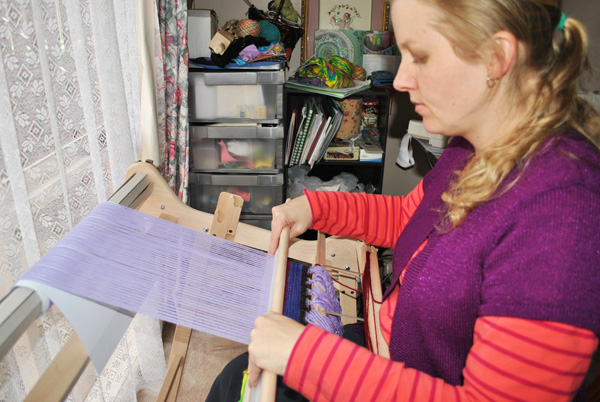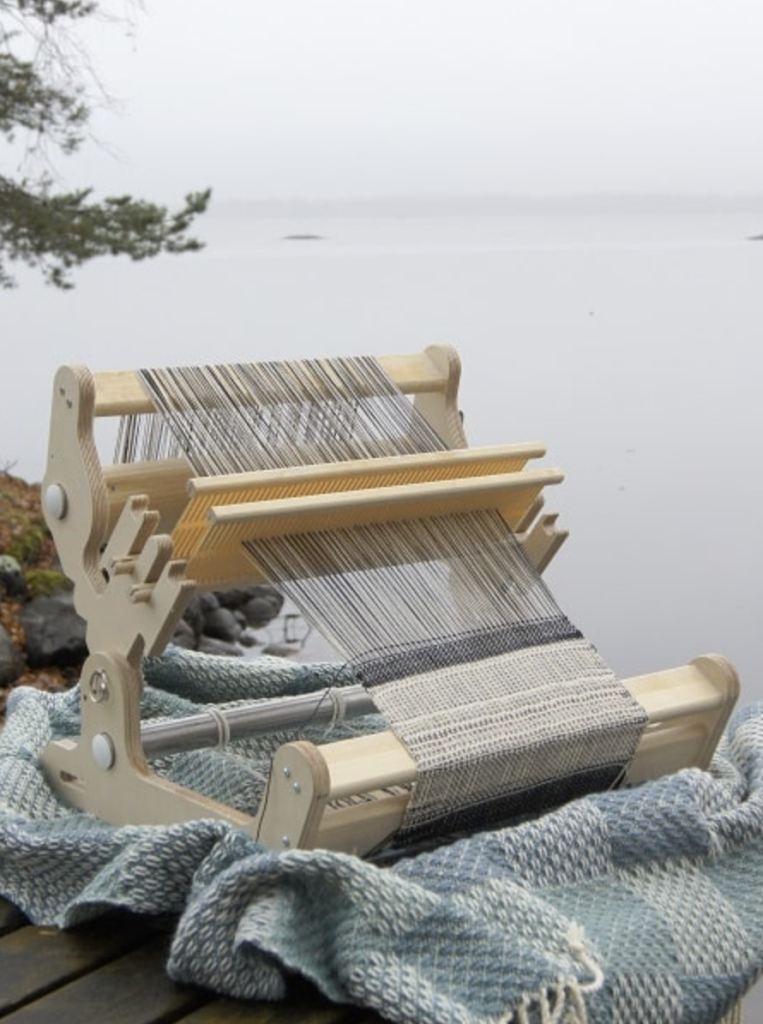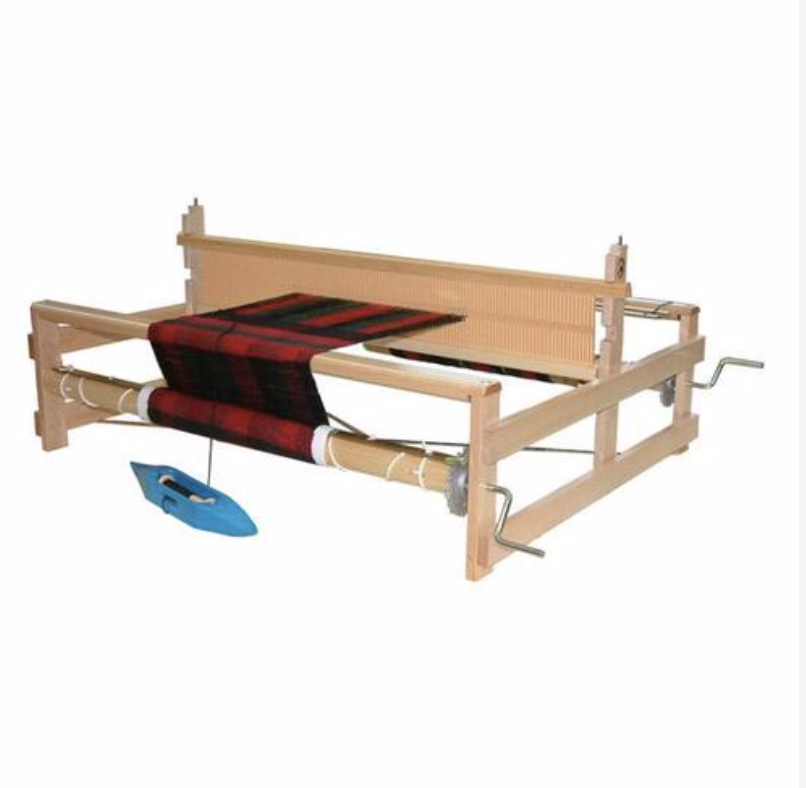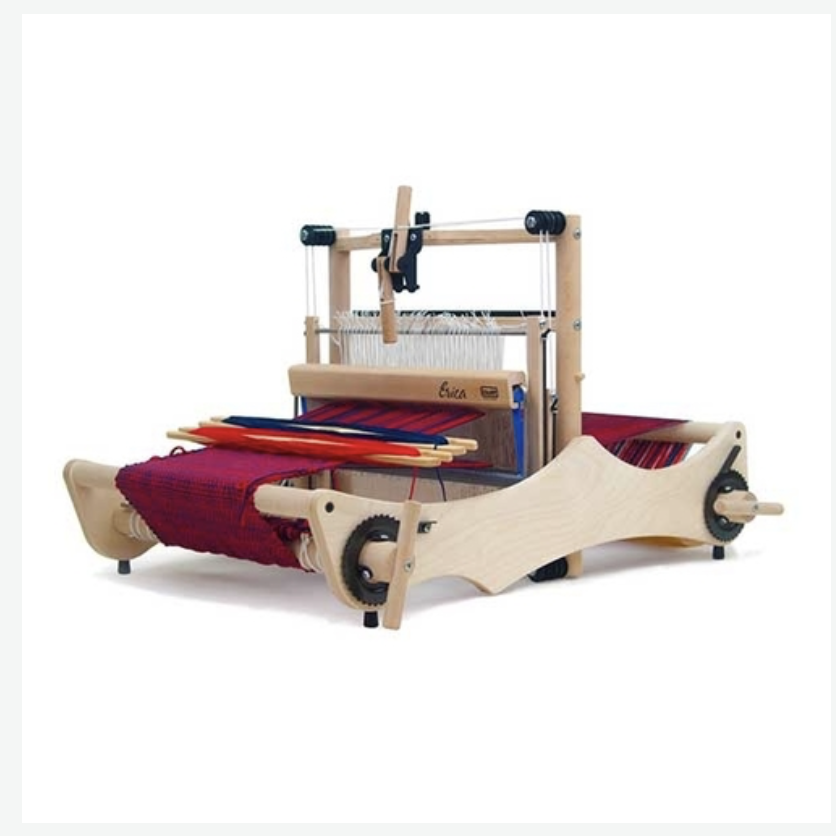Having only used Ashford rigid heddle looms, it is not really within my scope to compare different looms from a practical perspective. I can’t in fairness give appraisals of looms I have not used (though I’ve made it pretty clear that I love my Ashford!)
Cost is an important factor when considering your loom, and this is where I can help by offering a comparison of various looms and what will be included in the purchase cost.
Not all looms are going to be the same size, so I am going to compare looms of similar size but not always equal. I’m using Amazon for comparisons, but will use other sites if any particular loom is not available on Amazon.
*This post contains some affiliate links. This means that if you click and purchase, I receive a small commission at no extra cost to you.
These prices do not take into account any additional costs such as stands, extra tools or shipping. All prices are in U.S. dollars.
Please also note that most rigid heddle looms come flat packed in a box, so unless you pick one up in a store where an assembly service is offered (usually for a fee), you can expect to be putting the loom together yourself.
Let’s start with the first rigid heddle loom I ever bought and still use constantly.
Ashford 24″ Rigid Heddle Loom-
Listed at $225, this loom comes with a standard 7.5 dent heddle, warping peg, 2 clamps, a threading hook, 2 shuttles, cardboard warping sticks and an instruction booklet. Made from Silver beech hardwood in New Zealand. *Edited to add – this loom now comes with a built in warping board if you purchase the warping pegs separately.
Beka 24″ Rigid Heddle Loom-
Listed for $159.99. Comes with one 10 dent heddle, two stick shuttles, one pickup stick, a pair of heddle blocks, threading tool and complete instructions. SG series looms are made from Cherry wood and finished with Danish Oil. Made in Minnesota, USA.
Schacht Flip Rigid Heddle Loom 25″
Listed at $335, this loom includes a 10-dent reed, warping peg, 2 shuttles, threading hook, and complete warping and weaving instructions. It is foldable and made in America from maple wood.
Glimakra Emilia Rigid Heddle Loom 18″
Listed for $279, this loom is made of birch and is foldable. It includes a 10 dent heddle, shuttle, warping peg, two clamps and a sleying and threading hook. Made in Sweden.
Kromski Harp Forte 16″
Prices starting at $279, this one is interesting. Kromski claim that you will not get a “complete package” with any other RH loom, and that seems to be true. This loom is designed to also be used as a warping board, I think that is quite innovative! I rarely warp my rigid heddle loom indirectly, so it’s not a feature that I would use, but for those who prefer to warp from a warping board, this is a really good deal. You don’t have the extra expense or purchasing a warping board separately and you don’t need the extra space. Smart! Kromski say that this loom also comes with a “warp helper” but I’m not sure what they mean by that.
The Harp is also foldable and as a bonus, the wood is already finished, so you can assemble right away.
A somewhat obscure loom is the Toika Siru Rigid Heddle Loom, 16″. Made in Finland in a classic raw wood, minimalist style, these looms start at around $260 USD.
These looms have an interesting design, with a metal bar and thick back cloth beam. They are foldable and seem to come standard with a double heddle block, which is handy for those wanting to use more than one heddle. You won’t generally find this loom for sale in the usual places (Amazon, large yarn or supplies stores) though other Toika looms are not too hard to find.
Leclerc Bergere Rigid Heddle Loom 24″
Price for this size is $285. This one comes with a blue boat shuttle! The Leclerc looks to be a very basic, sturdy design. I’m not sure what to think of the metal handles for tensioning, I feel like that may not be so comfortable.
This loom comes with extra warping blocks, lease sticks and extra shuttles, but doesn’t seem to include a reed or threading hook.
Erica by Louet.
I’m being a bit sneaky including the Erica by Louet in this list. It’s not actually a rigid heddle loom, but it is a 2 shaft table loom. So why include it in a rigid heddle comparisons list? Well, I get a massive number of messages from new weavers who are trying to decide between a rigid heddle loom and a table loom. I almost always recommend a rigid heddle (but not always, it depends on the circumstances of the person asking) but I would definitely not rule out something like the Erica. Here is why:
*It’s like a rigid heddle and table loom rolled into one. It has the same basic shape/frame and tensioning pegs as a RHL, but the “castle” (the upright part!), heddles, shafts and reed as a table loom.
*It’s a fantastic introduction to weaving on a table or floor loom. You have the functionality of a sturdy, upright loom with texsolv heddles without being overwhelmed by too many shafts.
*You have the option to upgrade later to 3 or 4 shafts, increasing the possibilities for your weaving.
With prices starting at $370USD, this is definitely a higher priced entry point loom, but still very reasonable for it’s capabilities.
*It’s foldable and light enough to pick up and put in the car for workshops, teaching or travelling.
I hope this collection has helped you to understand a little more about what you will pay when purchasing a new rigid heddle loom. If I have missed any, please mention them in the comments below!





Kelly I’m interested in purchasing your weaving school for Rigid Heddle Only. Is there a separate one for rigid heddles?
Also I have a 32″ Kromski and I know you have a 24″ Ashford. Can I still learn from your weaving school with a different loom. I am a beginner
Hi Melody,
Yes, you can definitely still learn on your Kromski from my classes.
I don’t have a separate membership level for loom types, but the majority of my classes are for rigid heddle looms anyway. If you don’t want to take out a membership you have the option of single purchase classes 😊
Hi Kelly! I’m trying to buy a RH loom, but my head is spinning! I’ve narrowed it down to the Ashford RH (16″) or the Ashford Sample-It (16″), but I’m unsure which to go with. I’m not going to have the budget for a stand, so I don’t think I should go any larger, even though a 24″ will let me do more sewing with the resulting fabric, I think? Anyway, I’m unsure what the real difference between the standard RH and the Sample-It is, aside from price… Do you happen to know what the difference is? And which would you choose, if you were a beginner like me?
Hi Oliver,
The difference between the 24″ and 16″ Sampleit is really just size and price.
I started out with a 24″ RH and it was an excellent choice. I do have a 10″ Sampleit as well, but I bought that later on, both as an extra loom for when my girls wanted to weave and so that I would have something quick and easy to sample on.
Here is what I recommend for you, based on what you’ve said about budget and your desire to sew with your fabric:
I would buy the 24″. There is only a $60 difference between it and the 16″, but the extra width is fully worth it. Even if you have to spend a little longer saving for the bigger size. I see a great deal of weavers buy a smaller size and then regret it, as they very quickly find they want the extra weaving width.
Now, weaving with a stand is definitely more comfortable, but a 24″ can also be propped against a table at an angle (it is designed to be able to do this) and weave that way.
If at all possible, I would try to save for a stand as soon as you can, but it is very feasible to get started without one and therefore not have as great an upfront cost.
Of course, you do not have to take my advice, the 16″ is still a great option to start out with, but I hope my thoughts help you to formulate what is going to best suit your situation.
I do have some articles that might help:
http://kellycasanovaweavinglessons.com/2021/04/what-can-i-weave-on-a-small-loom.html
http://kellycasanovaweavinglessons.com/2019/12/should-i-buy-a-larger-loom.html
If you have any further questions, be sure to let me know 😉
I have Leclerc Bergere 24″. My main issue is the locking mechanism on the cranks is not working. My first project it popped and let tension loose when bumped. I tightened it and it worked for second. I am halfway thru a tea towel and it popped again. It just ruins the tension and I just can’t get it back the same way. Very frustrating.
Tracy, do you think this is a fault with the loom? Have you contacted Leclerc to discuss the issue? There may be a replacement part you could get to fix it.
Bags : The Kromski, Flip, Cricket, and Ashford looms all offer a bag option. This is a great way to protect your loom if you travel with it or to keep dust off of it when not weaving on the loom. Additional Rigid Heddles : Since the rigid heddle dictates the yarn that is used to weave with most RH weavers end up with all the different sizes of heddles.
I’ve been going back and forth about which larger RHL I want to get (I already have a 10 inch Schacht Cricket) I know I’d be happy with just about any of them, I think I’d really like to get an Ashford knitters loom at 28 inches. It folds, it’s ready to go as far as assembly is concerned, and it’s a good size.
I haven’t used a knitter’s loom, but have heard from many weavers who have one and love it.
I have a Schacht Flip 25″ and find it to be very sturdy and easy to use. I have never had any issues with my loom and parts and accessories are easily obtainable. I do have to tighten the screws from time to time, but that is basic loom maintenance for any loom. I have the stand and two of every size of rigid heddle available for it. My next project will likely be a baby blanket woven with two heddles for double width. I have been itching to try double weave. As soon as I wipe out some of my more pressing projects, I will get to work on the blanket.
Best of luck with your blanket, weaving double width is a lot of fun!
Great article, Kelly! Two additions:
1. All Ashford looms now come with a built-in second heddle block: Sampleit, regular rigid heddle looms and the knitters loom.
2. Through the end of the year (I think), Ashford has a special on the 16″ Sampleit loom: loom, three reeds, two shuttles, two pickup sticks, Ashford book on rigid heddle weaving, houndstooth scarf starter project including pattern and yarn, and the carrying bag) for $299. While this loom is not as robust as the regular Ashford rigid heddle (you can’t add the cloth extender on the front end, for example) it’s an excellent general purpose loom and a great way to experiment with rigid heddle weaving. You can get this package from just about every weaving shop, and I’ve seen folks advertise it on Etsy too.
Lorraine
Great, thanks for your additions Lorraine 🙂
Hi Kelly, I recently purchased the Ashford rigid heddle and stand. Thought I should mention that for a nominal amount you can purchase a set of warping pegs to put in holes on the bottom of the loom to create a warping board for indirect warping. I have tried it and it did work-what I can’t figure out now is how to get the warp on the back due to the plastic connectors that are not removeable. Most other looms are attached with twine so you can move the rod to the side for warping.
It is similar to the Kromski warping feature.
Interesting. Cynthia just pointed out in another comment that the Ashford now comes standard with the built in warping board. I wonder if you can get a look at the new design to get an idea of how they avoid the plastic ties?
Judy, I just found this picture, it seems they have removed the plastic ties – http://woolery.com/ashford-rigid-heddle-warping-pegs.html
Hi Kelly,
Having just purchased the Ashford 24” loom, it now comes with a warping board built in on the bottom of the frame. You do have to purchase the pegs separately. I have not used it because I love the direct warping.
Happy weaving!
Well, I did not know that, thanks Cynthia 🙂
I just wanted to mention, I have the Schacht 25″ RH loom and it also has built in heddle blocks for a 2nd heddle
Great, thanks Mary.
I am in the UK and bought a second-hand Erika loom from Glimakra. It is quite difficult to get additional items for the Erika here – I was fortunate in that my purchase included all 3 heddles available, but it’s proving tricky to get the double-heddle fitting for the loom.
Thanks for the review, hopefully it will help folks make the best choices for their needs and pocket <3
Good advice for those looking for a loom, many will find it very helpful I’m sure. You forgot to mention one loom easily turns into two…..three……four 😃
Ah yes, so true!
Oh! I forgot to mention that the Ashford Knitter’s Loom now ships with a double heddle block.
You have to love that!
Thank you, Kelly, for your interesting comparison list. This past spring, I invested in my first loom–the 70cm Ashford Knitters Loom, and I couldn’t be happier! I mention this here, because it is also foldable (like others that are included on your list). It is flat-packed, but it is very easily assembled and has a lovely finish. I purchased it together with the carrying bag and a stand.
Being so pleased with ASHFORD, I went on to choose the Ashford Super Jumbo e-spinner (it was a very generous gift from my ex-husband). Now, I am saving up for an Ashford Drum Carder. I love their Student Hand Carders.
(No, I am in no way affiliated with Ashford!)
________
It was an excellent decision to include the Louët Erica Loom–it really is an intriguing design.
Something to consider about the built-in warping board on the Kromski Harp: while this is an excellent space-saver for indirect warping, anyone who wishes to use the hybrid-warping procedure will be disappointed, because the bottom of the loom itself is used to do the warping.
Thanks for your insights Karil 🙂
Regarding the Kromski warp helper: it’s a handy tool for direct warping. You place the helper on the frame in front of the back beam and slide the back dowel rod into the helper so the available end is positioned behind the part of the reed that you’ll begin warping. (For example, if you’re only warping a third of the reed’s width, you position the end of the dowel a third of the way from the end of the reed.) After you pull the yarn through the reed, you slip the yarn onto the end of the dowel. As you make your way down the reed, you slide the dowel in further (sliding it through the strings on the back beam where required) so that you can always put your yarn over the end of the dowel. I always use this tool when I’m warping directly! I can’t share a photo of it now because I’m mid-project on my Harp loom, but if you’re still interested, I can show how it works next time I’m warping!
That sounds like a fantastic tool Stacey!
I think that feature is amazing-only wish they had something like this for the Ashford.
It’ll work for indirect warping as well…